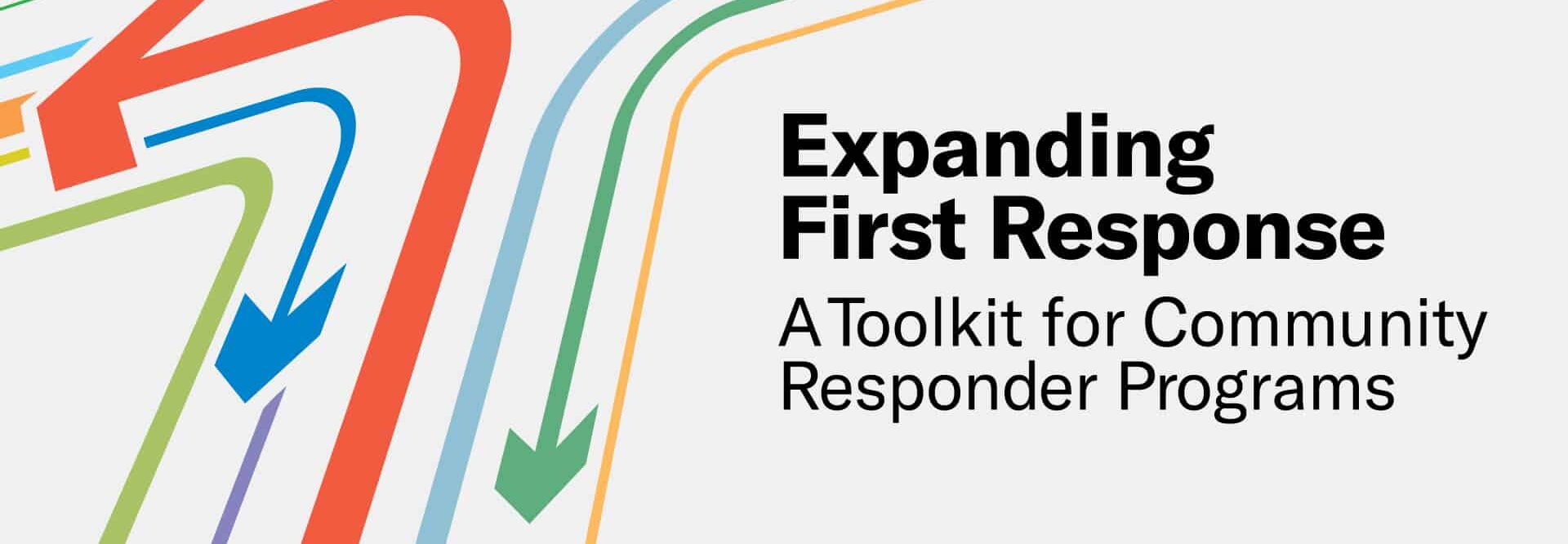
Explainer: A Breakdown of Community Responder Program Staff Models and Structures
As interest in community responder programs grows across the country, one of the most crucial elements of establishing these programs is deciding who makes up the actual team of responders. While there is no set formula for determining staff members—as a program’s staffing model and structure will vary based upon which needs are most pressing for a local community—there are some common patterns among existing and successful programs. Here are answers to three frequently asked questions about staffing community responder teams:
Are there certain types of professions or members of the community who are typically hired as community responders?
Programs may hire and train a variety of people depending on the needs and resources of the jurisdiction, such as trusted members of the community, health professionals, and more. Below are some examples of professionals and members of the community who have been hired by existing community responder programs:
- Behavioral Health Specialist: A behavioral health or crisis intervention specialist who is generally an unlicensed person with professional training, sometimes with a bachelor’s degree in a related field, and who focuses on providing immediate mobile response, specialized assessment, service referrals to treatment, and follow-up support for a person experiencing a behavioral health crisis.
- Community Health Worker: A public health worker, such as a community member who has received training to properly identify medical needs and can determine whether additional emergency care is needed. In some states, there is certification available for community health workers.
- Community Member Trained in Crisis Response: These may be individuals who have lived experience and extensive knowledge about the communities most impacted by the program. These community members are typically interested in supporting crisis response and should receive training on ways to best support people in crisis, such as on de-escalation, mediation, and trauma.
- Emergency Medical Technician (EMT): A technician, also sometimes called a community paramedic, who provides life support and pre-hospital emergency medical care to individuals. An EMT might also provide pre-arrival notifications to receiving emergency departments before transferring patients to medical facilities.
- Graduate-Level Intern: A student and responder-in-training who can help address calls for service, conduct follow ups, and make referrals to mental health providers in an assistant-level capacity.
- Harm Reduction Specialist: A responder who can provide on-demand services, such as transportation to emergency shelters and connections to other service providers. They may also address immediate needs, including helping people obtain shelter, food, and clothing. In addition, they build one-on-one relationships with business owners, residents, and law enforcement officers to provide support for diversions.
- Licensed Clinical Social Worker (LCSW): A LCSW holds a master’s degree in social work, has passed a written social work examination, and typically receives licensure after having at least two years of supervised work experience. Responding in-person or by phone, they are trained to screen and assess people experiencing crisis with mental health and substance use and provide therapeutic interventions, case management, and personalized services to divert mental health, substance use, and overdose calls from police to community-based mental health providers.
- Marriage and Family Therapist (MFT): A licensed therapist who can provide intensive counseling, psychotherapy, case management and treatment services, treatment plans, and referrals to appropriate community agencies. An MFT should also have patient case files that have detailed records of prescribed and received treatment.
- Nurse: A licensed nurse who establishes therapeutic relationships with patients and performs psychiatric medication management, mental health assessment and diagnosis, individualized case management, and lab result review.
- Outreach Worker: A person who responds either in-person or by phone to people experiencing mental health issues, inebriation, homelessness, or a substance use crisis. Performing proactive response and outreach, this responder can visit people sleeping in homeless encampments and follow up with individuals from previous calls to provide services. Outreach staff should receive training in trauma-informed care, first aid, and triage, as they are expected to stay connected to recipients of care and serve as their guide during the case management process. Ideally, outreach workers will be from or live in the communities they serve and may have lived experience in the issues they help to address.
- Peer Support Specialist: A person who has lived experience with mental illness, substance use disorder, homelessness, and/or another behavioral health-related issue and has been trained as a specialist. There is formal training for peer support specialists available in most states, and the service can be Medicaid billable. Their role typically includes de-escalating situations, promoting engagement in care, and fostering relationships between residents and other community responders.
- Psychologist: A trained and licensed professional who can conduct psychological evaluation and long-term individual and group psychotherapy, as well as provide crisis intervention on an ongoing basis. For example, a psychologist can provide continuous services designed to treat patients with extensive histories of hospitalization, incarceration, and other forms of justice system contact.
How many people do community responder teams typically include?
Generally, community responder teams consist of two to four people per team based upon the community’s needs and available resources. Two-person teams can employ responders who respectively specialize in mental health/substance use and medical care, allowing the pair to address both medical and psychiatric needs of residents. However, there are teams that employ two harm reduction specialists or community members. Three- or four-person teams at times take on a multidisciplinary approach and incorporate multiple professions, such as mental health specialists, emergency medical technicians, and peer-support specialists.
Which organization oversees the community responder program, and how does this affect staffing?
There are three types of lead agencies that are generally responsible for staffing responder teams:
- Nonprofit-based teams: Community responder programs led by nonprofits allow staff to operate confidentially and autonomously as an alternative to police, in contrast to programs that operate as an extension of a government-run agency. In many instances, the nonprofit agencies overseeing community responder programs also initially advocated for the community responder model and have direct relationships to residents in the community. One challenge with this approach can be establishing connections with local service providers so that staff can carry out referral and diversion processes with 911 dispatch centers, which are often run through local and county governments.
- Existing government agency-based teams: A local government might choose to staff a community responder team by expanding an existing agency (e.g., through a fire department, police department, emergency medical services, health department, etc.) due to its existing connections to the city’s 911 dispatch center. Utilizing existing infrastructure and connections of an existing government agency can assist in connections across the local government and connections to other service delivery. However, if a community responder program is mandated through city legislation, this can potentially limit the flexibility of the staff hiring process due to department eligibility requirements and clearance needed.
- New government agency-based teams: Within a new agency, community responder staff can operate independently of existing local government agencies while also having access to city government funding through a dedicated line item in the city’s budget. This is a new model to develop additional community safety around crises, and in some cases, other responses. Limitations around staff hiring and government mistrust, however, can still apply to this model.
To learn more about community responder programs, visit Expanding First Response, a toolkit that serves as a central hub for states and local communities looking to establish or strengthen community responder programs.
About the author

 New Hampshire Continues Justice Reinvestment Effort to Improve Conditions for People Who Are High Utilizers of Criminal Justice and Behavioral Health Systems
Read More
New Hampshire Continues Justice Reinvestment Effort to Improve Conditions for People Who Are High Utilizers of Criminal Justice and Behavioral Health Systems
Read More
 New Hampshire Commission Reviews Final Policy Recommendations to Reduce Reliance on Incarceration as Part of Justice Reinvestment Initiative
Read More
New Hampshire Commission Reviews Final Policy Recommendations to Reduce Reliance on Incarceration as Part of Justice Reinvestment Initiative
Read More
 Three Things to Know About New Jersey’s Groundbreaking Community Response Legislation
Three Things to Know About New Jersey’s Groundbreaking Community Response Legislation
In response to growing calls for police reform in New Jersey, particularly following the shootings of Najee Seabrooks and Andrew Washington in March and August 2023, a coalition of law enforcement officials, mental health professionals, and community advocates partnered to explore public safety response alternatives.
Read More












